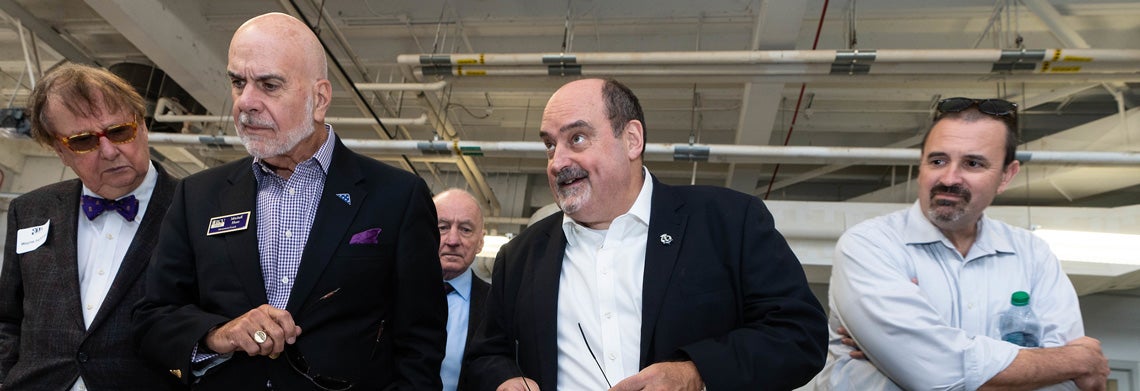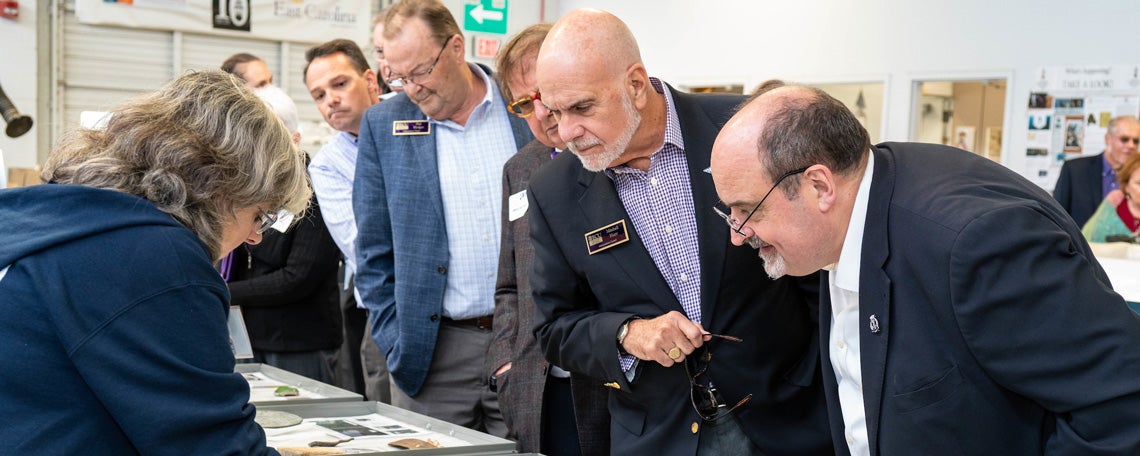FACT OR FICTION
Voyages lecturer discusses Blackbeard during 300-year anniversary of death
On Oct. 25, Angus Konstam, historian and pirate expert, led an audience of Greenville community members and East Carolina University faculty, staff and students through a brief history of the pirate Blackbeard during his discussion, “Blackbeard at 300: New Findings on North Carolina’s Most (In)famous Pirate.”
“Pirate blood courses through our veins,” said Dr. William M. Downs, dean of the Thomas Harriot College of Arts and Sciences, in his welcoming remarks at the kickoff event for the 2018-19 Voyages of Discovery Series at ECU.
“As someone who knew only the very basics about Blackbeard, and pirates in general, I thought it was cool to learn more about the history and how so much of it was related to North Carolina,” senior and Harriot College student worker Madison Laney said. “As an ECU Pirate, I’m glad I now know some interesting Pirate facts.”
While curating artifacts for the Royal Armouries at the Tower of London, Konstam began to wonder what items could be linked to pirates and how to distinguish fact from fiction. Thus began his research on pirates.
Konstam described how he visited the British archives to locate any historical records on pirates, including Captain Edward Teach (Teague, Thack, Thatch or Thatcher in various documents), also known as Blackbeard.
“It is detective work,” Konstam said. “A puzzle that never stops giving.”
Stories indicate that Blackbeard may have been born in either Jamaica or Bristol, England, though no records have been discovered at this time to prove the exact location or date of his birth.
During the War of Spanish Succession from 1701-1714, privateering was a form of legalized piracy approved by the government. Once the war ended, privateering ended and ex-privateers who did not want to give up their way of life became pirates.
In 1715, a ship filled with treasures was attacked, looted and sunk off the coast of Florida, beginning the age of the pirates. From 1716-1718, New Providence Island, a small island in the Bahamas, served as the base for salvagers and pirates to rid themselves of cargo they did not want – other than gold, currency or alcohol, said Konstam.
The first historical record attributed to Captain Thatch describes a pirate attack in December 1716 with a crew of 70-90 men and 7 guns. Later, in the spring of 1717, another attack is reported referencing Thatch. It was not until the fall of 1717, however, that Konstam said a record of a pirate attack by Captain Thatch or Teach is then referred to as Blackbeard.

THCAS Dean’s Advancement Council members (left to right) Wayne Holloman, Mitchell Hunt and Jim Mullen, Voyages guest speaker Angus Konstam (center), and ECU chemistry department chair Dr. Andrew Morehead (right) listen as guides describe artifacts removed from the sunken pirate ship, the Queen Anne’s Revenge.
“I found Blackbeard intriguing,” Konstam said in a meeting with students earlier in the day. “I was hooked.”
Blackbeard was said to have attacked the slave ship La Concorde on Nov. 17, 1717. He discarded the cargo and converted the ship into the Queen Anne’s Revenge, a snub to the royal establishment.
Konstam said that Blackbeard attacked a few ships off Antigua, later hid out in the Caribbean and went off the radar until mid-1718, when he began picking off shipwrecks on the coast from Florida to South Carolina, stopping ships, capturing people, stealing money and in effect holding the port for ransom.
“There is no account that Blackbeard ever killed anyone, until his final battle,” Konstam said. He indicated that Teach’s long, black beard, which was unusual for the time period, was most likely an intimidation tactic that made him “look scary,” causing people to surrender.
“If you are going to be a pirate, look scary,” Konstam said.
Pirates were interfering with the trade business in various ports, said Konstam. So the British governor offered a majority of pirates a pardon in 1718, eliminating New Providence Island as a refuge and allowing the government to hunt for any remaining pirates, including Blackbeard.
The Royal Navy was after Blackbeard, and Konstam said he needed to downsize his operation, which is why historians believe Blackbeard may have decided to run his ship aground in the Topsail Inlet and captain a smaller, faster ship known as a sloop. Historical debate continues over whether the grounding of the Queen Anee’s Revenge was intentional.
Blackbeard traveled to Bath, North Carolina, seeking a pardon, but while trying to establish a legitimate life in Ocracoke, it is said Blackbeard continued to lead attacks in the Delaware River. The governors of Delaware and Philadelphia hired Naval officers to hunt down Blackbeard, and on Nov. 22, 1718, they came to Ocracoke, and upon his sloop, attacked and killed Blackbeard, captured his crew, and delivered them to Virginia, where they were put on trial and executed in mass hangings.
“New information is coming out all the time, which is changing the story,” Konstam said. “There are still a lot of questions about Blackbeard.”
According to Konstam, there are many parts of Blackbeard’s life that are still unknown, including where and when he was born, whether he really took a teenage bride in Bath and how old he was when he died. No historical records have surfaced to answer these questions.
Earlier in the afternoon, Konstam visited the Queen Anne’s Revenge laboratory, where he had the opportunity to view artifacts recovered from the wreckage of the ship.
Konstam said he was “blown away by the material on display,” and that the lab provides a “valuable resource of international importance for which North Carolina can be very proud.”
Twenty ECU students, whose majors ranged from biology and chemistry to archaeology, criminal justice, English, political science and philosophy, also had the opportunity to meet informally with Konstam during the day. They asked Konstam about his research findings, how historically accurate the portrayal of pirates are in Hollywood (not very), and why Blackbeard named his ship the Queen Anne’s Revenge (a sign of rebellion).
While meeting with the students, Konstam emphasized that a lot of pirates operated during the 18th and 19th centuries from various nations, including France, Spain and China, and that Blackbeard might not have been the most successful pirate of his time but is better known than others because of his story and intimidating appearance.
Konstam is a former naval officer, underwater archaeologist and museum curator who specializes in maritime and military history. Konstam is best known for his work on piracy and is the author of more than 100 books, including “History of Pirates and Blackbeard: America’s Most Notorious Pirate.”

Angus Konstam (right) looks on as Sarah Watkins-Kenney (left), from the QAR lab, describes artifacts retrieved from the Queen Anne’s Revenge. Also pictured (left to right) are ECU chemistry professor Jack Pender, and THCAS Dean’s Advancement Council members Phil Hodges, Wayne Holloman and Mitchell Hunt.
